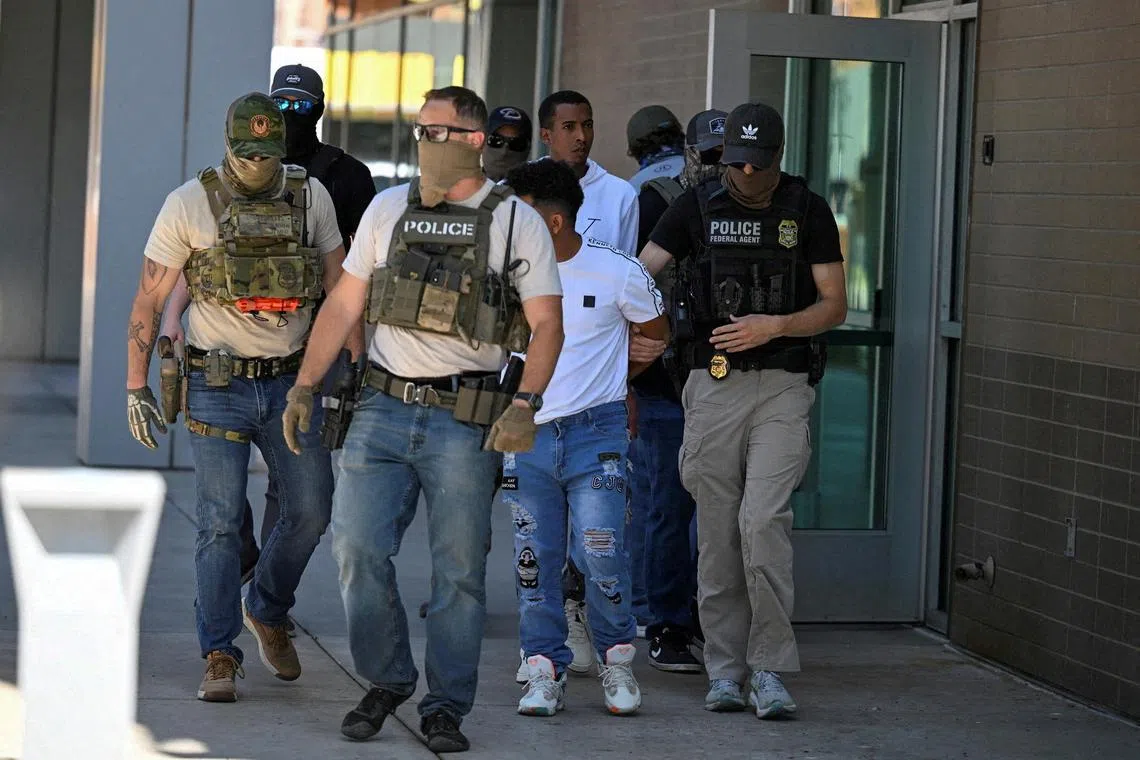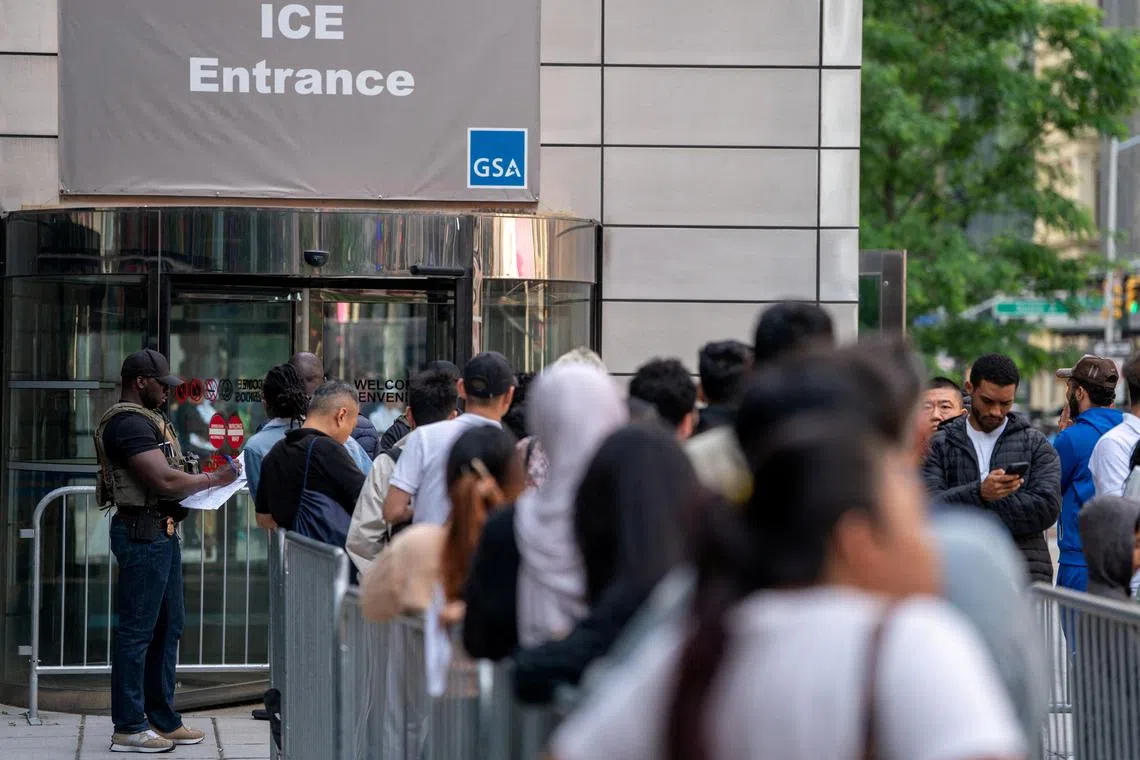Inside ICE, Trump’s migrant crackdown is taking a toll on the agency officers
Sign up now: Get ST's newsletters delivered to your inbox
Follow topic:
WASHINGTON – Under US President Donald Trump, the Immigration and Customs Enforcement (ICE) agency has become the driving force of his sweeping crackdown on migrants, bolstered by record funding and new latitude to conduct raids.
But its employees are contending with long hours and growing public outrage
Two current and nine former ICE officials told Reuters the agency is grappling with burnout and frustration among personnel, as agents struggle to keep pace with the administration’s aggressive enforcement agenda.
The agency has launched a recruitment drive to relieve the stress by hiring thousands of new officers as quickly as possible, but that process will likely take months, or years, to play out.
All of those interviewed by Reuters backed immigration enforcement in principle. But they criticised the Trump administration’s push for high daily arrest quotas that have led to the detention of thousands of individuals with no criminal record
Most of the current and former ICE officials requested anonymity due to concerns about retaliation against themselves or former colleagues.
Americans have been inundated with images on social media of often masked agents in tactical gear handcuffing people on neighbourhood streets, at worksites, outside schools, churches, and courthouses, and in their driveways. Videos of some arrests have gone viral, fuelling public anger over the tactics.
Under Mr Trump, average daily arrests by the 21,000-strong agency have soared, up over 250 per cent in June compared with a year earlier, although daily arrest rates dropped in July.
Mr Trump has said he wants to deport “the worst of the worst”, but ICE figures show a rise in non-criminals being picked up.
ICE arrests of people with no other charges or convictions beyond immigration violations during Mr Trump’s first six months in office rose to 221 people per day, from 80 people per day during the same period under former president Joe Biden in 2024, according to agency data obtained by the Deportation Data Project at University of California, Berkeley, School of Law.
Some 69 per cent of immigration arrests under Mr Trump were of people with a criminal conviction or pending charge, the figures show.
Some ICE investigators are frustrated that hundreds of specialised ICE investigative agents, who normally focus on serious crimes such as human trafficking and transnational gangs, have been reassigned to routine immigration enforcement, two current and two former officials said.
In an interview with Reuters, Mr Trump’s border czar, Mr Tom Homan, acknowledged that the long hours and reassignment of specialist agents have frustrated some ICE personnel but said Mr Trump’s Jan 20 declaration of a national emergency around illegal immigration warranted it.
“There’s some staff that would rather be doing other types of investigations, I get that, but the president declared a national emergency,” Mr Homan said.
Mr Homan, who spent three decades in immigration enforcement and joined ICE at its inception in 2003, said the long hours should lessen as hiring of new ICE staff speeds up.
“I think morale is good. I think morale will get even better as we bring more resources on,” he said.
Another stress factor for more senior officials is the perpetual threat of being removed for failure to produce arrests, underscored by multiple changes of leadership at ICE since Mr Trump took office in January, five of the ICE officials said.
In response to a request for comment, a senior official with the US Department of Homeland Security, ICE’s parent agency, downplayed concerns about morale, saying officers were most bothered by being targeted in assaults, as well as criticism from Democrats.
The senior official said ICE personnel “are excited to be able to do their jobs again” after being subjected to limits under Mr Biden.

Law enforcement officers, including HSI and ICE agents, take people into custody at an immigration court in Phoenix, Arizona.
PHOTO: REUTERS
Intense pressure
At the centre of the complaints, the current and former ICE officials said, was the demand by the White House for ICE to sharply increase immigration arrest numbers to about 3,000 a day
In some cases, officers on raids have gone to wrong addresses following leads that relied on artificial intelligence, increasing the chances of picking up the wrong person or putting an officer in danger, according to one current and two former officials.
“The demands they placed on us were unrealistic. It was not done in a safe manner or the manner to make us most successful,” the current official said.
During recent raids in several US cities, masked ICE agents have been confronted by angry residents demanding they identify themselves and chasing them out of neighbourhoods.
“In a lot of communities, they’re not looked upon favourably for the work they do. So I’m sure that’s stressful for them and their families,” said Ms Kerry Doyle, a former top legal adviser at ICE.
ICE also faced backlash during Mr Trump’s 2017-2021 presidency, when activists and some Democrats made “Abolish ICE” a rallying cry, but the agency’s more aggressive enforcement in recent months has further thrust it into the spotlight.
Mr Trump’s public approval rating on immigration fell to 43 per cent in a Reuters/Ipsos poll in August from a high of 50 per cent in March, as Americans took an increasingly dim view of his heavy-handed tactics against migrants.
That view has been shaped in part by news reports of students being arrested on campuses or on their way to sports practice, parents being detained while dropping children at school, ICE officers breaking windows and pulling people from cars, and men surrounded and shackled while waiting at bus stops or at Home Depots to travel to work.
One former ICE official said at the beginning of the administration, several former colleagues told him they were happy the “cuffs are off”.
But several months later, he said, they are “overwhelmed” by the arrest numbers the administration is demanding.
“They would prefer to go back to focused targeting,” he said. “They used to be able to say: ‘We are arresting criminals.’”

An ICE agent speaks to people lined up to enter an immigration court in New York.
PHOTO: REUTERS
Hiring spree
A Republican-backed spending package passed by the US Congress in July gave ICE more money
The Trump administration has launched a vigorous recruitment drive on the back of the new funding to meet its goal of hiring 10,000 ICE officers over the next four years.
Using wartime-style posters and slogans
Homeland Security said more than 115,000 “patriotic Americans” had applied for jobs with ICE, although it did not say over what time period.
The ICE hiring spree resembles a similar surge to onboard Border Patrol agents in the mid-2000s, which critics say increased corruption and misconduct in its ranks.
Asked about the risk of bringing in less qualified people in the rush to staff up, Mr Homan said ICE should choose “quality over quantity”.
“Officers still need to go through background investigations, they still need to be vetted, they still need to make sure they go to the academy,” Mr Homan said. REUTERS

